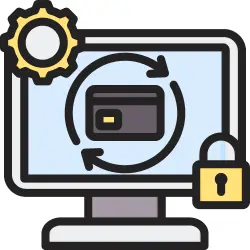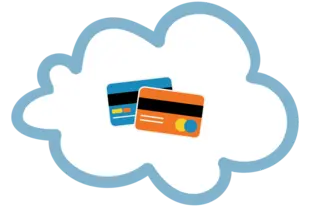TABLE OF CONTENTS

With more than 470,000 business applications submitted per month in the United States, new entrepreneurs are seeking payment processing partners to handle customer credit card payments.[1]United States Census Bureau. “Business Formation Statistics“. Accessed March 5, 2024. However, some traditional merchant service providers don’t provide merchant accounts to new businesses or businesses in high-risk industries. Many business owners are seeking alternative payment arrangements, including PSPs, payment facilitators (also known as a “PayFac”), or other solutions.
Payment facilitators make payment processing more accessible for merchants by offering sub-merchant accounts. In doing so, they cut down the amount of time it takes to access payment processing and reduce the underwriting burden on small businesses. However, payment facilitators also have numerous downsides, so it’s essential to understand this type of payment provider before using one for your business’s credit card processing.
This guide explores payment facilitators, their business model, how they compare to other payment providers, and other related topics.
What Is a Payment Facilitator?
A payment facilitator (PayFac) is a financial intermediary that simplifies payment processing by aggregating multiple merchants under its own merchant account. It allows businesses to become “sub-merchants” under its merchant ID (MID).
A PayFac enables quick onboarding for smaller merchants by assuming responsibility for compliance, underwriting, and transaction processing. This streamlines the payment process, allowing businesses to accept payments without the traditional complexities associated with setting up individual merchant accounts.
How Does the PayFac Model Work?
Merchant accounts are challenging to obtain, especially for new or small businesses. That’s where payment facilitators enter the game. The PayFac model streamlines payment processing by allowing a payment facilitator to aggregate multiple merchants under its own merchant account. A payment facilitator obtains a merchant account (MID) and essentially “leases” access to “sub-merchants.” As a sub-merchant, a business can process payments via the payment facilitator’s merchant account; however, they don’t have dedicated access to the account.
The PayFac assumes responsibility for transaction processing and must also undertake compliance and underwriting to ensure merchants are suitable for payment processing. However, as merchants under the PayFac model don’t receive exclusive access to a merchant account, this process is much simpler and leads to quicker onboarding timeframes.
The Role of Visa and Mastercard
Visa and Mastercard are the nation’s largest card networks — they are integral to the world’s payment infrastructure. Visa and Mastercard set the rules and standards for card transactions, facilitate the flow of funds between banks, and ensure the security of transactions. Card networks have the power to penalize merchants and merchant account providers for bad behavior in the payment environment.
This is one of the many reasons why obtaining a dedicated merchant account for a business is challenging. So, while payment facilitators make this easier by grouping multiple merchants onto a single account, they must still follow the rules of Visa and Mastercard.
What’s the Difference Between PayFacs and Other Solutions?
The payment landscape continues to develop as modern technology evolves. Now more payment solutions are available to merchants in the United States. So, how does a payment facilitator stack up against other payment systems? Let’s find out:

PayFac vs. Payment Processor
A payment facilitator (PayFac) is an entity that simplifies payment processing for multiple businesses by aggregating them under a master merchant account, streamlining onboarding. In contrast, a payment processor is a service that facilitates the actual transaction, transmitting payment data between the merchant and the issuing bank to authorize and complete the payment. While a payment processor focuses on the technical aspects of transactions, a PayFac goes beyond, often assuming some risk and providing a more streamlined onboarding process for businesses, making it easier for them to accept payments.

PayFac vs. ISO
An Independent Sales Organization (ISO) acts as a sales agent for payment processors or banks, facilitating merchant acquisition but typically not assuming risk or providing the same level of streamlined onboarding as a PayFac. While both play roles in the payments industry, PayFac integrates merchants directly into its system. In contrast, an ISO focuses on sales and acquiring merchant accounts for traditional processors or banks.

PayFac vs. Merchant of Record
A Merchant of Record (MoR) is an entity that assumes legal and financial responsibilities for payment transactions on behalf of individual merchants. It manages the compliance and underwriting — and often assumes more risk. In contrast, a Payment Facilitator (PayFac) aggregates multiple merchants under its master account, simplifying onboarding by taking on some risk and administrative tasks. While both facilitate payments, an MoR maintains direct relationships with individual merchants, handling a broader scope of responsibilities compared to a PayFac.

PayFac vs. Aggregator
Payment aggregators and PayFacs offer differing approaches to handling merchant transactions. Aggregators simplify setup with one Merchant ID for all transactions, while PayFacs assign unique IDs to each sub-merchant. PayFacs typically provide a broader range of services, including integration, fraud protection, and customer support. While aggregators provide fast onboarding for small businesses, PayFacs undertake more detailed risk assessments. PayFacs also assumes more responsibility for compliance and risk management, potentially leading to higher fees.

PayFac vs. PSP
A PayFac is a type of payment service provider (PSP) that aggregates merchants under its own merchant account, simplifying onboarding and payment processing. While a PSP broadly encompasses various service providers in the payment ecosystem, a PayFac specifically integrates a simplified model where merchants can quickly access payment services without extensive underwriting. PayFacs assume more responsibility for compliance and risk management, offering a streamlined solution. On the other hand, PSPs may offer a range of payment services without necessarily aggregating merchants in the same manner.

PayFac vs. Payment Gateway
A payment gateway is a secure online portal designed to verify payment details and communicate transaction information to a payment processor. Payment gateways make it simple to accept online payments. They’re responsible for encrypting payment data and communicating it securely, ensuring customer payment details aren’t stolen during purchasing.

On the other hand, a payment facilitator is an entity that streamlines the onboarding process for multiple merchants by aggregating them under its master merchant account. The PayFac model simplifies the setup for businesses, handling aspects like underwriting and risk. While a payment gateway is a technology solution, a PayFac is more of a business model that simplifies merchant onboarding and payment processing. PayFacs may provide payment gateways to their merchants as a product.

PayFac vs. Merchant Service Provider
A merchant service provider is a payment company offering merchant accounts and other payment tools to its clients. A business typically contacts a merchant service provider if it wants access to a dedicated merchant account.
On the other hand, payment facilitators don’t offer dedicated merchant accounts. They group multiple merchants together as sub-merchants on a single merchant account. This speeds up the sign-up and underwriting process but leaves merchants with less control over their payment infrastructure.
Pros and Cons of a Payment Facilitator
As with any payment solution, there are pros and cons associated with using a payment facilitator:
Advantages
- Quick Sign-Up Process
- Limited Underwriting
- Software Integration Benefits
- Scalability
- Reduced Administrative Burden
- Access to Analytics
Disadvantages
- No Dedicated Merchant Account
- Higher Processing Fees
- Limited Support
- Often Restricted to Other Software Platforms
PayFac Example Companies
While you may not frequently see the term “payment facilitator,” some of the world’s most recognizable payment companies operate on this model. Let’s explore some examples in more detail below:

Stripe
Stripe operates as a Payment Facilitator (PayFac) by providing a simplified onboarding process for businesses to accept online payments. As a PayFac, Stripe aggregates multiple merchants under its master merchant account. This eliminates the need for individual merchants to establish their merchant accounts, streamlining the setup process. Stripe manages the underwriting, compliance, and payment processing infrastructure, simplifying the overall experience for businesses.

Square
Square made its name by offering the most compact card readers on the market. Its square-shaped readers plug into auxiliary and charging ports on phones, making accepting payments on the go simple. However, Square now has a range of online and in-person payment processing solutions, including virtual terminals, POS systems, eCommerce integrations, and more. As with Stripe, Square groups multiple merchants onto a single merchant account. While it has its own underwriting process, it’s much less intrusive than a traditional merchant account provider. Square will also send you a free card reader if you’re a new merchant!

PayPal
PayPal originally made its name as a peer-to-peer digital wallet, allowing users to transfer money to each other digitally. However, the firm now offers a range of payment services, including payment processing for in-person and online businesses. As with other payment facilitators, PayPal merges multiple sub-merchants onto a single merchant account, speeding up the onboarding process for business owners. However, PayPal might not be the best choice if you’re seeking payment stability — it faced a lawsuit in 2022 for freezing funds without warning.[2]Bloomberg. “PayPal Sued for Freezing Customer Accounts Without Explanation“. Accessed March 5, 2024.
How to Choose the Right Payment Facilitator
If your business wants to use a payment facilitator to access credit card and debit card processing, choosing the best partner for the job is critical. There are now countless payment facilitators on the market, so you’re spoiled for choice if you want to switch to a new payment provider. Let’s explore some tips and tricks for choosing the right payment facilitator for your business:

Do Your Research
First, start by researching the payment facilitators relevant to your business. You can’t make a good decision on a payment processing partner without a deep dive into the best options on the market. Start by creating a list of payment features your business requires, such as in-person payments, online payments, chargeback prevention tools, integration with third-party marketplaces, etc. Create a shortlist of the best candidates that meet your requirements.

Compare Your Options
Once you have a shortlist of payment facilitators to consider, it’s time for an in-depth comparison. It’s critical to avoid working with payment facilitators with poor customer service records. Use consumer watchdog groups, such as the Better Business Bureau, to determine if there are any glaring issues with the payment facilitators on your list.

Assess Fees and Pricing Structure
One of the most essential factors to consider is processing fees and pricing structure. Firstly, the type of pricing offered by your payment facilitator. For example, do they offer flat-rate pricing or Interchange Plus pricing? While flat rate pricing makes it simpler to predict future processing costs, it’s usually more expensive than interchange pricing, which charges different fees depending on the card network and other factors. Next, compare overall processing fees to determine which PayFac is the best value for your business.

Look for Integration Support
If you want to integrate your new payment system with existing software, finding a payment facilitator with integration support is critical. Unless your business has a technical programming team ready to integrate software programs with one another, it’s essential your new payment facilitator can streamline the synchronization process. A lack of integration support can lead to inefficiencies, lost data, and a range of other issues.

Review Security Features
Next, it’s time to assess the security features available from your payment facilitator. There are more than one million cases of identity theft reported annually, and the most common form of identity theft is credit card fraud.[3]The Motley Fool. “Identity Theft and Credit Card Fraud Statistics for 2023“. Accessed March 5, 2024. This leaves businesses prone to scams, chargebacks, and other payment issues, resulting in losses. Your payment facilitator’s fraud and chargeback prevention tools must be reviewed to ensure they’re up to scratch.
Considering a payment facilitator’s security features is crucial for safeguarding customer payment data, preventing fraud, and maintaining trust. Robust security measures protect both businesses and customers from potential financial risks and data breaches.
Consider a Merchant Service Provider
Lastly, payment facilitators are advantageous for smaller businesses seeking quick setup and simplicity, but they have downsides. As merchants using payment facilitators only have “sub-merchant” accounts, they have much less control over their payment infrastructure. Accounts or funds may be frozen without warning. Likewise, many payment facilitators include large markups in their processing rates, sometimes without any transparency.
A merchant account may be preferable for businesses with specific needs, high transaction volumes, or complex processing requirements. Merchant accounts offer more customization, direct relationships with acquiring banks, and potentially lower fees for larger enterprises. Likewise, many merchant account providers offer Interchange Plus pricing, which is a much more transparent and affordable pricing model than flat-rate pricing. Apply for a merchant account with PaymentCloud today!





